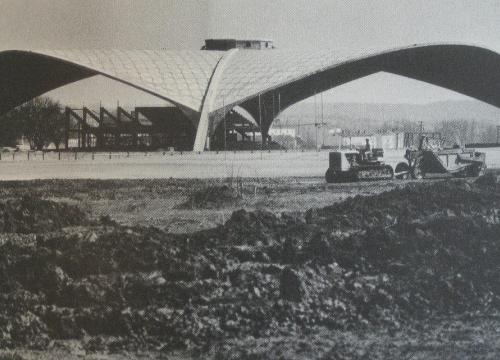Stegeman Coliseum – UGA 1654 (1964, renovated 2006; Category 4). Stegeman Coliseum was constructed in 1964 across Carlton Street from the Georgia Continuing Education Center. When built, the coliseum was intended as a multi-purpose facility that could accommodate a variety of events and had a removable basketball floor. The building was named in memory of Herman James Stegeman in 1996. An addition was added in 2005–2007, and the building was substantially renovated in 2011.
Planning for the coliseum dates to the 1953 Aeck Campus Development Plan for the University, which outlined the new modern vision for campus growth. The area where the coliseum was placed had been used for athletics and accommodated a variety of athletic facilities by the end of World War II. 1947 and 1951 plans of the University show a baseball field in the future building’s location. The 1953 master plan, however, clearly depicts the round form of the coliseum in the location where it was eventually built, including the reconfiguration of roads around it.
Completion of the long awaited multi-purpose facility provided the University with the first building in many years that would accommodate the entire student body for an event. The coliseum, with its round shape and undulating overhanging roofline, became a notable architectural landmark on the campus and contributed to modernization of the campus appearance. Jointly shared by the athletic department and College of Agriculture, the structure housed every possible event, from basketball games to rodeos, to academic convocations, to livestock exhibitions and science fairs. When built, the coliseum was the largest single structure on the campus.
Stegeman Coliseum is a unique and significant architectural and engineering structure on campus. The building is comprised of a pair of large arching concrete beams supporting four thin concrete shells, one in each quadrant of the round plan, that rise high into the air. Facing Carton and Smith Streets, on opposite sides, the shells are open and have been enclosed with an expanse of structural glass in recent renovations. On the other two elevations, the shell covers concrete walls that are perforated with patterned windows and decorative elements. The concrete forms are painted grey. A rectangular wing attached to the east side of the round building appears to have been original and shows in 1967 and 1983 campus plans.
Stegeman Coliseum is significant to the University’s Mid-Century Modern period of development. Along with the 1960 Low-rise Dormitories and Science Complex, the coliseum is probably the most significant building of that era on campus. The building has been modified by enclosure of the open shells with structural glass and additions to the east side of the building.

